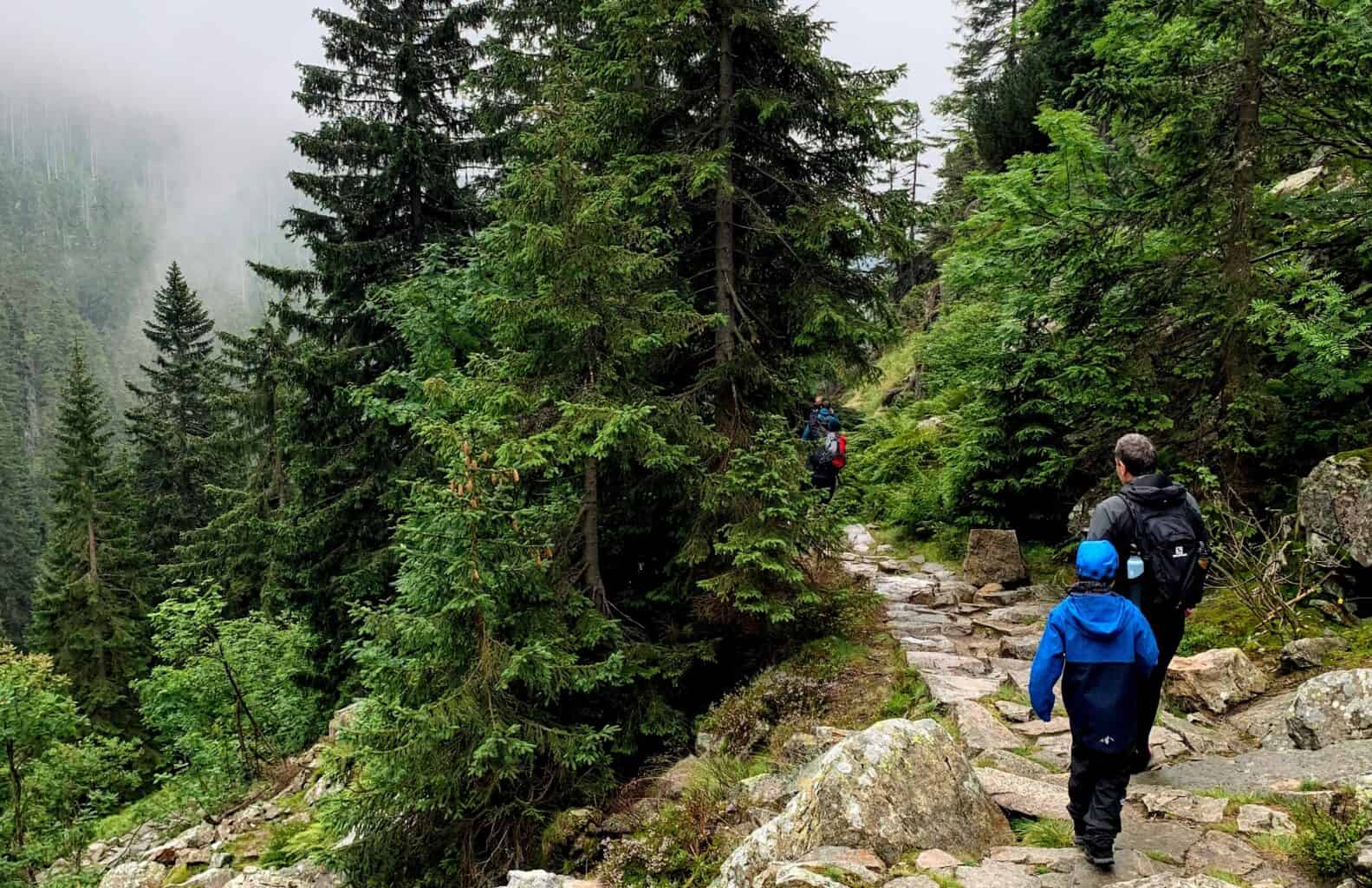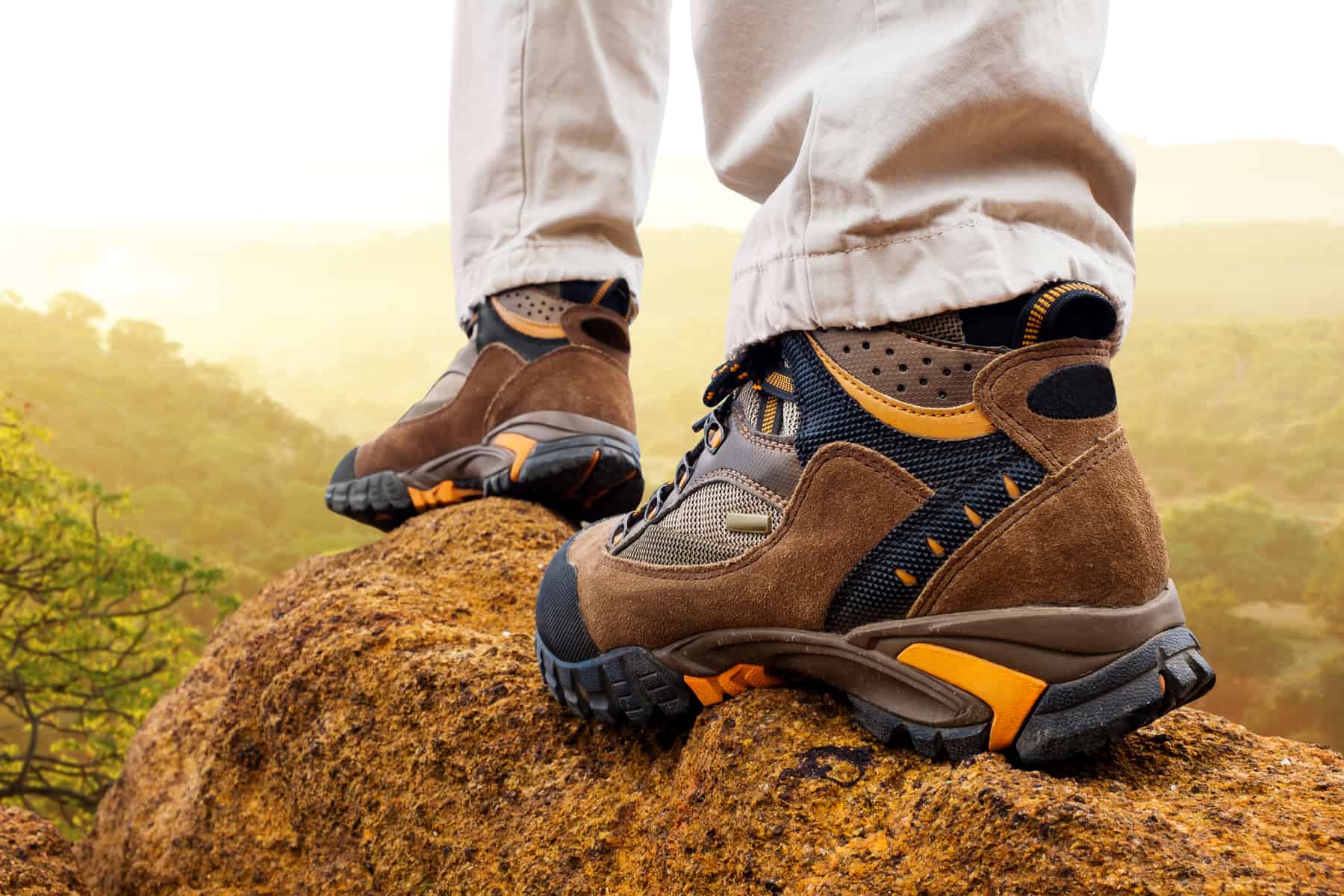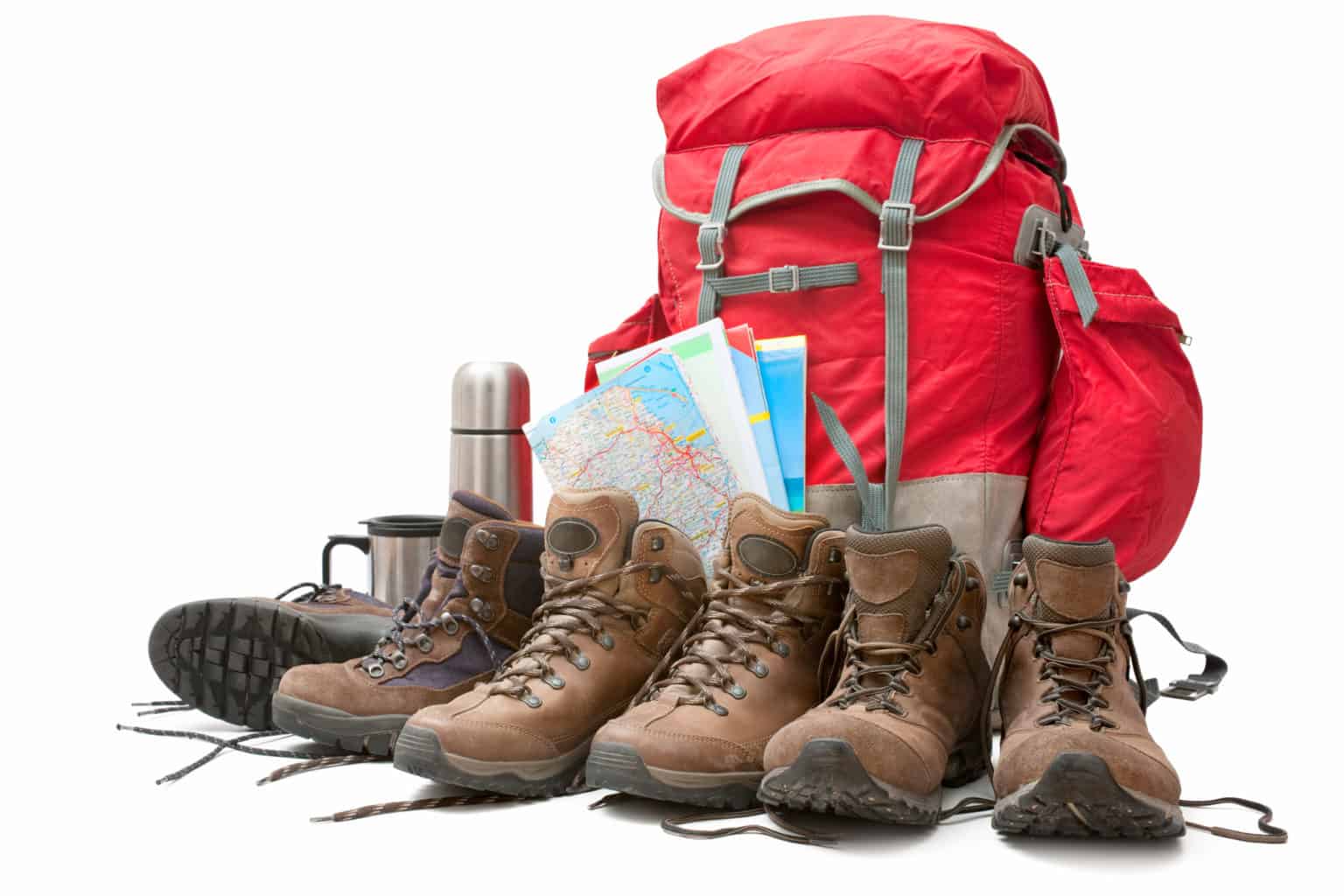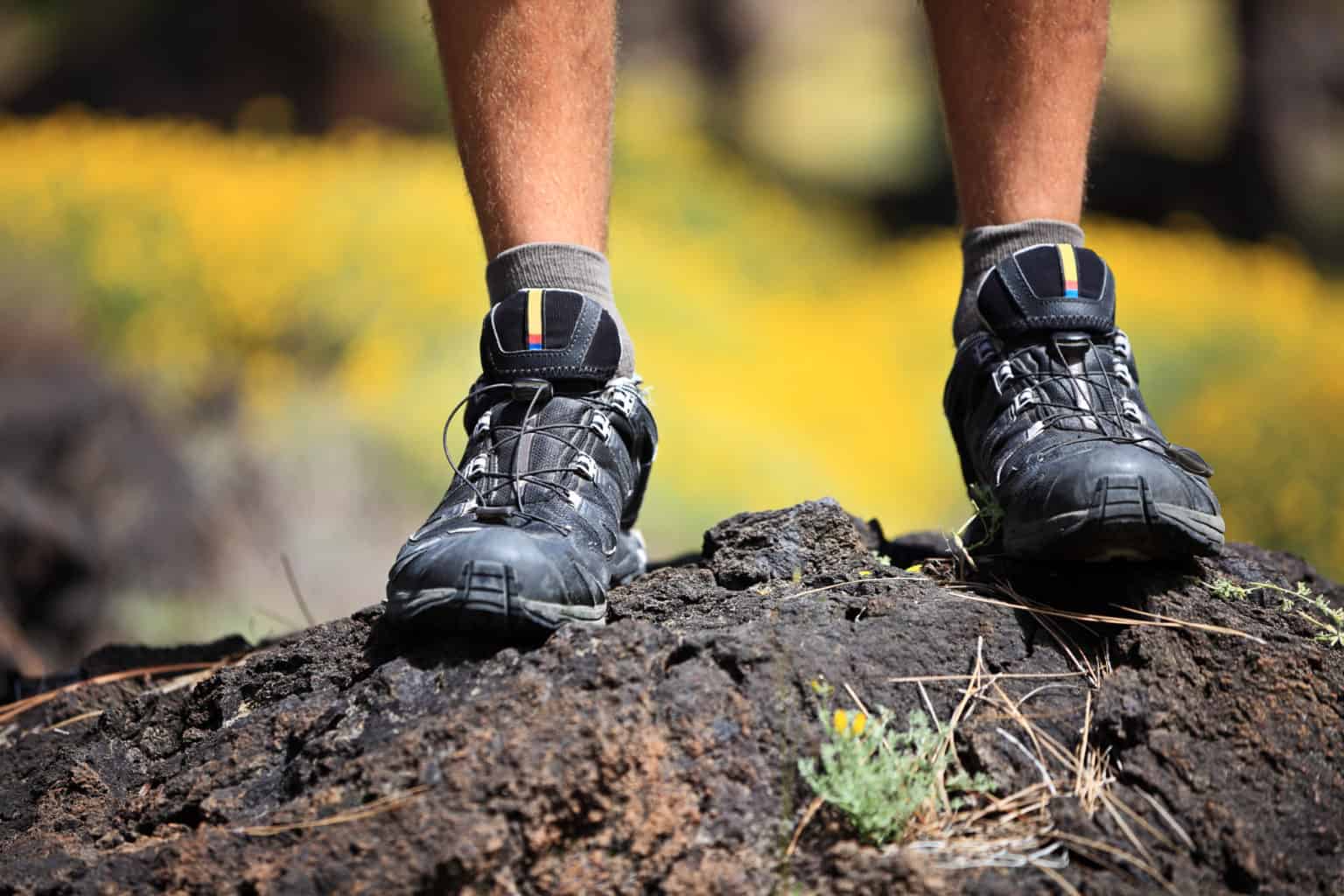Whether you’re a weekend hiker or a die-hard hiking fan, you know how crucial it is to wear proper footwear while you’re hiking. A lot of casual hikers quickly learn that they just can’t use their regular sneakers for a serious outdoor adventure. When the terrain that’s not flat, manicured or groomed, you need a pair of quality hiking boots or hiking shoes.
Fortunately, today’s market offers a number of different types of hiking footwear. These include mountaineering boots, approach shoes, low hiking shoes, barefoot shoes, trail runners, thru-hikers, and lightweight hiking shoes for day hikers. While all of these different types can make anyone’s head spin, all of them fall into one of two main categories – hiking shoes and hiking boots – though I have also written a comparison between Trail Runners and Hiking Shoes.
However, for newbie hikers, it can be fairly difficult to make a choice between boots and shoes. Remember – the wrong footwear is guaranteed to lead to an uncomfortable day trekking or even debilitating black toenails and painful blisters. While the right boots or shoes make it easy to walk hundreds of miles without any of these problems. So, should you get yourself a pair of hiking boots or hiking shoes?
Note: it’s all to do with your feet, the terrain, and the weather.
To help, I’ll break down the key differences between these two and by the end of the article, you should be able to make the right decision and get yourself a pair of hiking boots or hiking shoes that will last.
What Are Hiking Boots?
Years ago, leather boots were the only kind of hiking boots you could get. These were large, heavy, bulky mixtures of rubber and leather – it’s what our parents and grandparents used for their day hikes into the “Great Outdoors”.
The goal of these old-fashioned boots was to protect one’s feet at all costs. They were made with rugged metal hardware and tended to have high tops. In addition, lacing them up was sometimes a time-consuming task – but you simply had no other choice.
However, even with all their faults, early hiking boots were a crucial and inseparable part of every backpacking trip. A leather boot kept your feet protected, dry, and warm. Wearing these boots meant you could hike any kind of terrain, no matter how steep or difficult it was.
Obviously, old hiking boots lacked in certain departments. Not only were they very hard to break in, (and sometimes that took a while), but also they were stiff, heavy, and sometimes quite ugly. The demand for more comfortable boots was always there, but the problem was the types of materials. Now we have newer manufacturing processes along with new materials. Together these have had a huge impact on the evolution of hiking boots.
In just a couple of decades, the hiking trails around the world started crawling with hiking boots that weren’t only good, but great. They started offering better ankle support. Their weight went down, and they became more comfortable and flexible. They also became equipped with materials that provide extra cushioning and more protection – just what you need when you want to hit the trail.
What Are Hiking Shoes?
In the simplest of terms, hiking shoes are actually a modern (and very successful) spinoff of the good-old boots. A modern hiking shoe (often called a trail runner, but not quite the same) is a versatile piece of hiking footwear and often resembles sneakers used by athletes. However, these provide better protection, cushioning, and traction – hiking in them is both safe and comfortable.
The best hiking shoes, or trail runners, are made out of premium materials that make them more flexible and lighter than your standard hiking boot. These improvements do not compromise their efficiency on hiking trails. Some of the high-performance features found on a modern trail running shoe include a sock-like bootie, a waterproof coating, a high-grip lug pattern, a protective upper material, and similar hiking-specific components.
In short, hiking shoes or trail runners are nimbler, lighter, easier to pack, and also easier to break in. In addition, they’re the best trekking buddies for those who often hike in warm weather. When it’s hot outside, moving in trail runners is much easier, and your feet will stay dry and cool.
As expected, the biggest disadvantage of trail runners is their durability. In other words, an average pair of trail runners will have to be swapped for a new one after some five hundred miles of use. Of course, this number totally depends on the wearer’s definition of “this shoe can’t be used anymore”. We’ll talk more about the differences between hiking shoes vs hiking boots in terms of durability later on.
Hiking Boots vs Hiking Shoes – The Differences
In terms of durability and comfort, both types of footwear provide good endurance and cushioning. The best backpacking boots and trail running shoes offer protection from trail hazards and can withstand most weather elements. In addition, both types look much more stylish than their predecessors.
However, there are still some key differences between them, and that is precisely what so many hiking newbies want to know more about. In the next part of the article, we’ll be comparing hiking shoes and boots in a number of different categories.
Ankle Support & Stability
Many hikers agree that ankle support is one of the most important factors to keep in mind if you’re a hiking beginner who is not yet accustomed to trekking rugged terrain. In addition, ankle support plays a huge role when you’re carrying a heavy backpack. In such circumstances, boots are usually the best choice.
In fact, comparing hiking boots vs trail running shoes in terms of ankle support doesn’t actually make a lot of sense. This is because most trail runners and hiking shoes don’t come over your ankles, they’re “low-cut”. For that matter, it’s pretty safe to say that a hiking boot will always provide better foot and ankle protection – it’s as simple as that.
Things become a bit trickier when it comes to stability – it all depends on the midsole found in a particular piece of footwear. For example, trail runners with quality polyurethane midsoles are exceptionally stable. However, most hiking shoes will feature lightweight and soft EVA midsoles – wearing such a shoe will never make you feel as stable as wearing a regular boot.
So, in terms of stability and ankle support, boots are a better choice. If you still want to buy a pair of trail runners but don’t want to compromise on stability, look for the ones with polyurethane midsoles.
Weight
Obviously, most trail running shoes will sport a lighter weight than most boots. Keep in mind that the weight of your footwear is vital – it has a huge impact on the comfort of your outdoor adventure, whether it’s a day hike or a thru-hike.
Another important thing to keep in mind here is that heavier gear also has an effect on your heart rate. When you’re trekking, you want to keep your heart rate somewhere between 40% to 70% of its maximum capacity, since staying in this range helps endurance. If you’re setting out on an 8-hour outdoor trekk, you certainly don’t want to get tired in just one hour because you’re carrying all that extra weight.
Unlike most boots, hiking shoes are made out of light materials and are, therefore, a clear winner in terms of overall weight.
Durability
If a particular piece of footwear is well-made (i.e. with high-quality glue and sturdy stitches), its longevity will mostly depend on the materials. And when it comes to hiking footwear, almost every boot and shoe will be made either out of leather or synthetic materials.
Unlike boots, hiking shoes are almost never made out of leather. This is because leather is too heavy for trail shoes, which need to be flexible and nimble. For that matter, a hiking shoe is never a good choice for exceptionally rocky terrains, where it could easily be subject to abrasion.
However, a lot of hiking enthusiasts only walk smooth forest trails (which are sometimes even paved). For these, a regular hiking shoe or a trail runner is a better choice due to its lower weight. Still, boots provide unmatched durability and are your best option if you need footwear that you’ll be able to use for years to come.
When talking about the longevity of boots and shoes for trekking, we also have to pay special attention to the durability of their midsoles. If you often hike with a heavy backpack, you’ll want to wear quality boots – with time, the extra weight increases wear and tear, which is something a boot will be able to handle. The midsoles found on trail runners quickly lose cushioning (they’ll become flat), as they’re not engineered to withstand heavy loads.
Waterproofing & Breathability
As it turns out, breathability and water resistance are quite interconnected when it comes to hiking footwear.
Waterproofing is undoubtedly a concept that looks wonderful on paper. However, in reality, it doesn’t do as well. This includes Gore-Tex, which is often advertised as the best type of waterproofing technology. I have written more about the differences between Omni-Tech vs Gore-Tex Technology.
As far as we’re concerned, the only individuals who genuinely need a waterproof hiking boot or shoe are thru-hikers who often go on long-distance adventures in cold weather. For all others, our advice is to simply get wet instead of trying to keep the water out. (My exception to this, there is always one, is boggy ground)
If this sounds like nonsense, keep in mind that shoes with breathable uppers may allow your feet to get wet more easily but they will also dry faster. In practical terms, this translates to your feet being dryer and, therefore, less susceptible to blisters when you’re out on the trail.
Unless you really need a pair of waterproof shoes, you’re better off without them. Always keep in mind that the Gore-Tex membrane can drastically decrease the breathability of trail shoes. Also, don’t forget that trekking boots come higher on your leg (going over the ankle) and it, therefore, covers more skin.
In summary, choosing a boot or shoe that’s breathable rather than water-resistant is a much better decision for most people. If you’re doing a lot of winter hiking, on the other hand, get yourself a pair of waterproof boots – these will keep your feet protected from freezing wind and rain.
Traction
Unlike shoes, hiking boots offer excellent traction – with soles made out of rubber, they grip rocky surfaces like no other type of footwear. In addition, a good trekking boot will have deep and thick lugs, and they will bite well into almost all types of soil.
On the other hand, standard trekking shoes aren’t that great when it comes to traction. Since they’re primarily designed for flat nature trails and forest trails, they feature outsoles that are less sticky and have less aggressive lugs.
Even though they’re designed for running in rough terrains, trail runners are even worse in terms of traction during regular hiking adventures. This is because they’re designed to provide sufficient traction only when a large force is applied, which is not something that takes place when you’re hiking instead of running.
Heal, Sole, & Arch Support
The heel on hiking boots provides far better support and cushioning. This can make a huge difference when hiking on rocks or down a mountain that is mostly from rock to rock – the support makes little difference when you are walking on soft dirt paths – see image below.

The sole and arch support are far better on boots than on shoes. It is best to think of hiking shoes as fair-weather hiking. That does not mean it needs to be short, I have hiked 500 miles over 30 days in shoes. Personally, I do not feel the arch support with shoes, and with boots there is a noticeable difference.
Hiking Shoes vs Hiking Boots – The Verdict
It goes without saying, that hiking boots are a better choice when it comes to technical terrain. A shoe will never protect your foot as well as a regular boot – these are much more rugged and protective. They protect one’s feet with a mixture of metal, rubber, and leather components. This also makes them more durable – with proper care, a pair of hiking boots can last for years.
In addition, this type of footwear features tougher uppers and higher tops. This, in turn, makes them more stable than trail runners. Hiking boots are a particularly good choice for folks who need additional ankle support, as well as for first-time hikers, many of whom are still in the process of developing their foot skills.
Hiking shoes, on the other hand, are more flexible and stretchier due to their mesh components and lower tops. Not only does this make them more breathable, but also lighter on one’s feet. However, remember that waterproof shoes take longer to dry – you don’t need a pair if you’re not into winter hiking.
While a shoe can’t really give your foot the same stability and protection as a regular trekking boot, it is far more versatile – the stylish look of modern hiking shoes allows outdoor enthusiasts to use them both inside and outside the city.
Recommendations Based on Hikes
This is what I wear for the following routes or day hikes:
- Camino de Santiago – hiking shoes, it is mostly paths and Crocs for the evenings
- Wicklow hills – depends, if I know it is a boggy route then boots, otherwise shoes
- West Highland Way – boots, it can get boggy – though many disagree with me here
- Pennine Way – boots, it gets wet
- Ben Nevis – boots, it can be fairly rocky and I really need the ankle support on the way down
- I walked all over the Canadian Rockies with only trail shoes.
Most of the time I will be wearing hiking shoes and only wear boots when I know it is going to be wet underfoot or rocky – I don’t care much if it is raining either is fine.
More Comparisson Questions
Since I first wrote this I have had a few questions, here I will do my best to answer them.
Are Walking Shoes the Same as Hiking Shoes?
Yes. In the UK people refer to them as walking shoes and in the US they are called hiking shoes. They are both exactly the same shoes, it is just cultural differences.
Are Hiking Shoes Good on Pavement?
It depends on what material the pavement is made from. If the pavement is made from cobble or granite then hiking shoes will slip a lot, but for all other materials, they are okay on pavements. Bear in mind your shoes will wear quicker as they are designed to be used on dirt paths.

I love hiking, backpacking, and camping. From the Camino de Santiago to the West Highland Way in Scotland or simply a great day hike on the weekend. Hiking refreshes me, my mind, and keeps my body reasonably fit. So far I have walked three Camino routes and many other long distance hikes in the UK, Canada, and around the rest of Europe. One of the best was my hike up Ben Nevis.




The only thing I would add is that I found a lot of the surface on the Camino to be quite hard and unyielding, either paved surface or hard packed earth and I was quite thankful for the extra padding from the soles
on my Salomon boots. They are lightweight boots and although their trail runners are very similar, the sole isn’t as thick.
Very good article. I shifted to hiking shoes because they are lightweight and I am shifting to ultralight backpacking